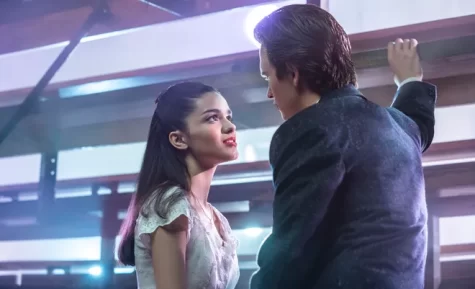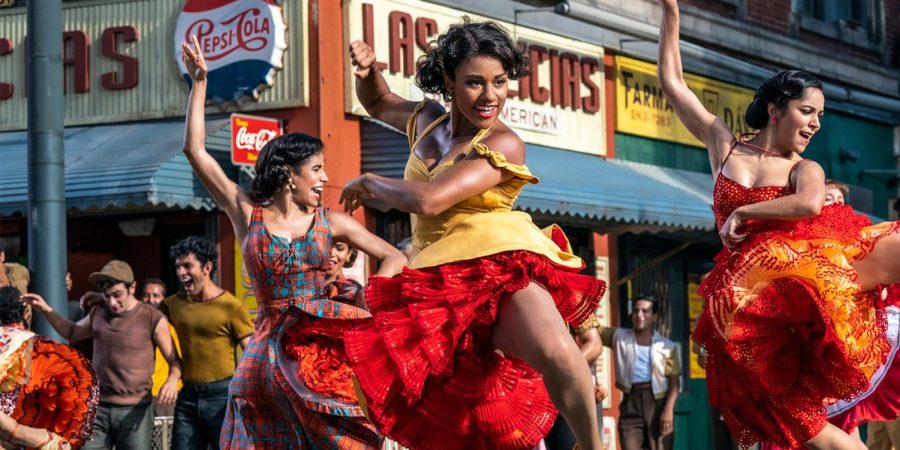“West Side Story”: less magic, more heart
April 7, 2022
In 1961, the movie-musical classic “West Side Story”, directed by Jerome Robbins and Robert Wise, was released. In December of 2021, fifty years later, a new adaption of the film, directed by Steven Spielberg, opened in theaters. The new remake mostly stays true to the original film, but there are some notable differences between the two. Some changes benefit the film, while others take away from the magic that made “West Side Story” so popular.
“West Side Story” is a retelling of “Romeo and Juliet”, set in New York City during the 1950s. It follows two rival gangs: the Jets and the Sharks. Tony, the former leader of the Jets, and Maria, the younger sister of the leader of the Sharks, meet at a dance and fall in love instantly. However, their newfound love results in conflict between the gangs, ending in tragedy for both sides.

Perhaps the most important change in the new film is the casting. Although many of the leading characters of “West Side Story” are Puerto Rican, the 1961 film is notorious for casting white actors in almost every role — using makeup to darken their skin. In the new production, the casting is significantly more diverse, with Latinx actors portraying every Puerto Rican character.
Another large adjustment to the film is the replacement of the character Doc with a new character called Valentina (Rita Morena). In the stage production and in the original movie, Doc is an older man who owns the convenience store that Tony works at. While he was semi-important to the plot, he served more as Tony’s employer than much else. Valentina, on the other hand, is a mother figure and a confidant to Tony. In the original, Tony did not have any familial figures and was rather one-dimensional next to other characters. His relationship with Valentina added much needed depth to his story.
The acting as a whole in the film was phenomenal with Ariana DeBose winning an Oscar for her role as Anita just two weeks ago. But the most impressive performance for me was Rachel Zegler in the role of Maria. Zegler, although not a newbie to the world of musical theater, had little previous experience with professional acting prior to “West Side Story”, with Spiellberg’s adaptation being her first feature film. A sixteen year old when she first auditioned, Zegler was selected out of over 30,000 applicants. Zegler breathes new life into Maria, with stunning vocals and powerful emotions, making you truly feel for her, both as she finds love, and as she loses it.

Opposite Zegler is Ansel Elgort in the role of Tony. Although I was pleasantly surprised by his singing, he seemed to fall short next to the other actors in the film. While Zegler brought passion and desperation into the scenes they shared, Elgort looked… bored. As tragedy after tragedy occurred, Elgort’s face resembled something similar to that of a baby who’d had his candy taken away from him, rather than that of a man who had just lost the people closest to him. Despite a nine-year history in films, beginning with “Carrie” in 2013, Elgort’s performance felt bland and static in comparison to his co-stars, drawing me out of the magic of the film.
My favorite part of “West Side Story” has always been the dancing. In the 1961 film, choreographer Jerome Robbins crafted every fight scene and tense moment to feel like a dance. Robbins’ choreography is a large contributor to the success and legacy of both the movie and the musical.
In the 2021 movie, choreographer Justin Peck invents new moves, adding his own touch to the classic with original choreography. Perhaps most significantly, he does not choreograph every scene. Each fight scene looks like and feels like a fight scene, creating a raw, terrifying, and panic filled atmosphere in a way that is entirely different from its predecessor.
On its own, I don’t mind Peck’s approach. However, as an adaptation of “West Side Story”, I do not believe it was the right call. Robbins’s ability to convey story and emotion through dance, even during scenes with little to no background music is truly what cemented “West Side Story”’s place in the dance world. “West Side Story” without constant dance feels almost like an entirely different story.
The attention to detail was impeccable throughout the entire film, particularly with the styling. Similar to the original, costume designer Paul Tazewell dressed the two groups of characters in different color schemes, putting the Jets in blues and greens and the Sharks in reds and yellows. The color coding creates a clear divide in scenes and dances with more cast members, creating a stunning visual effect and demonstrating the unity within each community.
It is difficult to say which film is better; both have their own charms. However, I can easily say that the new “West Side Story” holds its own, as both an excellent adaptation of a classic and as a film overall.





